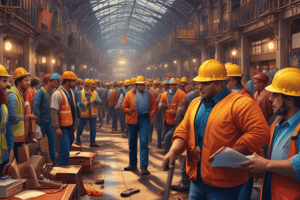Podcast
Questions and Answers
What is the primary goal of collective bargaining?
What is the primary goal of collective bargaining?
- To provide training and support to workers
- To resolve grievances and disputes
- To establish a union in a workplace
- To negotiate with employers to establish terms and conditions of employment (correct)
What is the term for the written contract outlining the terms and conditions of employment?
What is the term for the written contract outlining the terms and conditions of employment?
- Collective Bargaining Agreement (correct)
- Union Charter
- Labor Contract
- Employment Agreement
What is the structure of a labor union?
What is the structure of a labor union?
- International union, national union, local union (correct)
- Local union, national union, international union
- International union, local union, national union
- National union, local union, international union
Which of the following strikes led to union recognition?
Which of the following strikes led to union recognition?
What is one of the benefits of union membership?
What is one of the benefits of union membership?
What labor law protects workers' right to form and join unions?
What labor law protects workers' right to form and join unions?
What is the term for the group of elected leaders responsible for decision-making in a union?
What is the term for the group of elected leaders responsible for decision-making in a union?
What is the role of stewards in a union?
What is the role of stewards in a union?
Which of the following is an international labor organization?
Which of the following is an international labor organization?
What is the primary function of the bargaining unit?
What is the primary function of the bargaining unit?
Flashcards are hidden until you start studying
Study Notes
Collective Bargaining
- Process of negotiating with employers to establish terms and conditions of employment
- Union representatives bargain on behalf of workers to achieve better wages, benefits, and working conditions
- Key elements:
- Negotiating committee: Union representatives and employer representatives
- Bargaining unit: Group of workers covered by the collective bargaining agreement
- Collective bargaining agreement (CBA): Written contract outlining terms and conditions of employment
Union Organization
- Structure of a labor union:
- Local union: Smallest unit of organization, representing workers in a specific workplace or area
- National union: Larger organization that represents multiple local unions
- International union: Global organization that represents workers across countries
- Union leadership:
- President or chairperson: Elected leader of the union
- Executive board: Group of elected leaders responsible for decision-making
- Stewards: Union representatives responsible for enforcing the collective bargaining agreement
Strike History
- Major strikes in the United States:
- Haymarket affair (1886): Labor protest in Chicago that turned violent
- Pullman Strike (1894): Nationwide strike by railroad workers
- Flint Sit-Down Strike (1936-1937): Strike by autoworkers in Michigan that led to union recognition
- Notable strikes worldwide:
- French General Strike (1936): Strike by workers in France that led to improved working conditions
- UK Miners' Strike (1984-1985): Strike by coal miners in the UK that led to changes in labor laws
Worker Benefits
- Benefits of union membership:
- Higher wages and better benefits
- Improved working conditions and safety
- Job security and protection from unfair dismissal
- Training and education opportunities
- Collective bargaining power
Labor Laws
- Key labor laws in the United States:
- National Labor Relations Act (NLRA) (1935): Protects workers' right to form and join unions
- Fair Labor Standards Act (FLSA) (1938): Establishes minimum wage, overtime, and child labor standards
- Labor Management Reporting and Disclosure Act (LMRDA) (1959): Regulates union governance and financial reporting
- International labor laws:
- International Labour Organization (ILO) conventions: Set global standards for labor rights and protections
Stewards
- Role of stewards:
- Enforce the collective bargaining agreement
- Represent workers in grievances and disputes
- Communicate with union leadership and members
- Provide training and support to workers
- Act as a liaison between workers and management
Collective Bargaining
- Negotiation process between employers and union representatives to establish employment terms and conditions
- Aimed at achieving better wages, benefits, and working conditions for workers
- Key elements include negotiating committee, bargaining unit, and collective bargaining agreement (CBA)
Union Organization
- Local union: smallest unit of organization, representing workers in a specific workplace or area
- National union: larger organization representing multiple local unions
- International union: global organization representing workers across countries
- Union leadership includes president or chairperson, executive board, and stewards
Strike History
- Haymarket affair (1886): labor protest in Chicago that turned violent
- Pullman Strike (1894): nationwide strike by railroad workers
- Flint Sit-Down Strike (1936-1937): strike by autoworkers in Michigan that led to union recognition
- French General Strike (1936): strike by workers in France that led to improved working conditions
- UK Miners' Strike (1984-1985): strike by coal miners in the UK that led to changes in labor laws
Worker Benefits
- Higher wages and better benefits
- Improved working conditions and safety
- Job security and protection from unfair dismissal
- Training and education opportunities
- Collective bargaining power
Labor Laws
- National Labor Relations Act (NLRA) (1935): protects workers' right to form and join unions
- Fair Labor Standards Act (FLSA) (1938): establishes minimum wage, overtime, and child labor standards
- Labor Management Reporting and Disclosure Act (LMRDA) (1959): regulates union governance and financial reporting
- International Labour Organization (ILO) conventions: set global standards for labor rights and protections
Stewards
- Enforce the collective bargaining agreement
- Represent workers in grievances and disputes
- Communicate with union leadership and members
- Provide training and support to workers
- Act as a liaison between workers and management
Studying That Suits You
Use AI to generate personalized quizzes and flashcards to suit your learning preferences.




